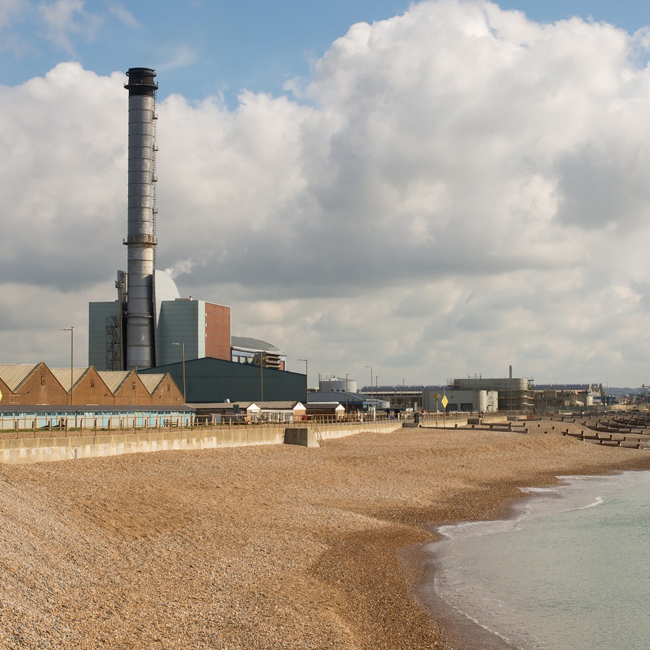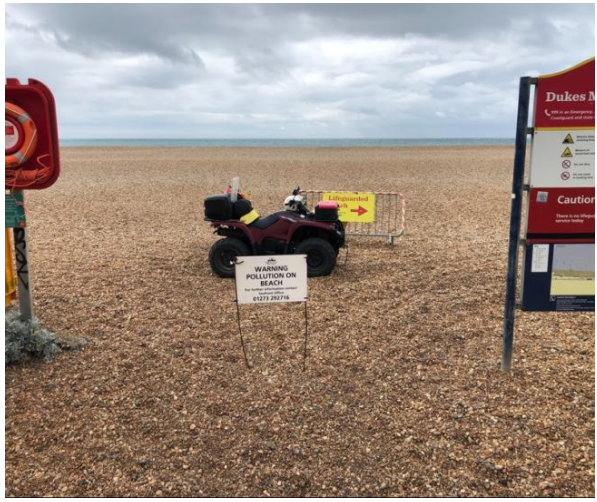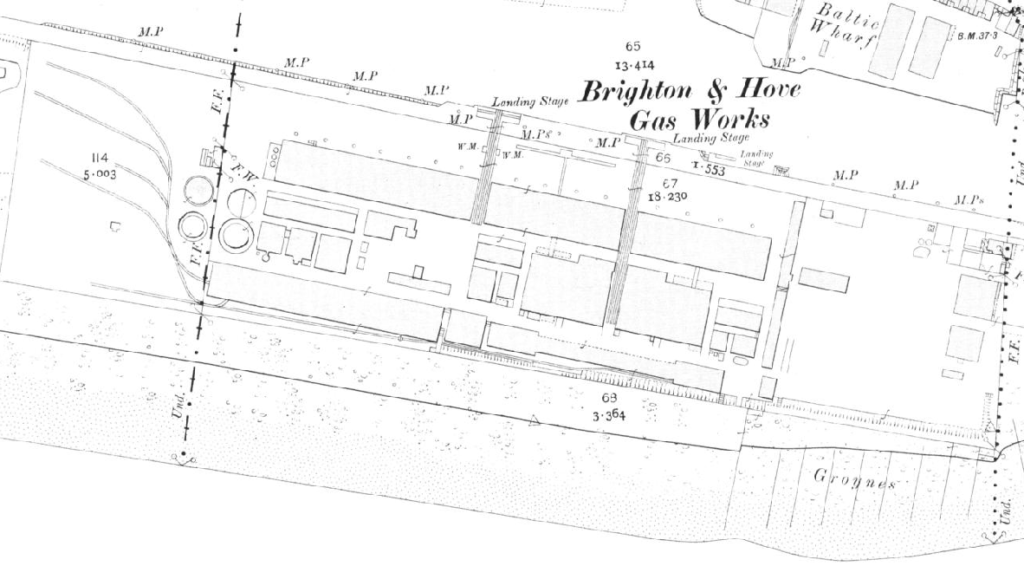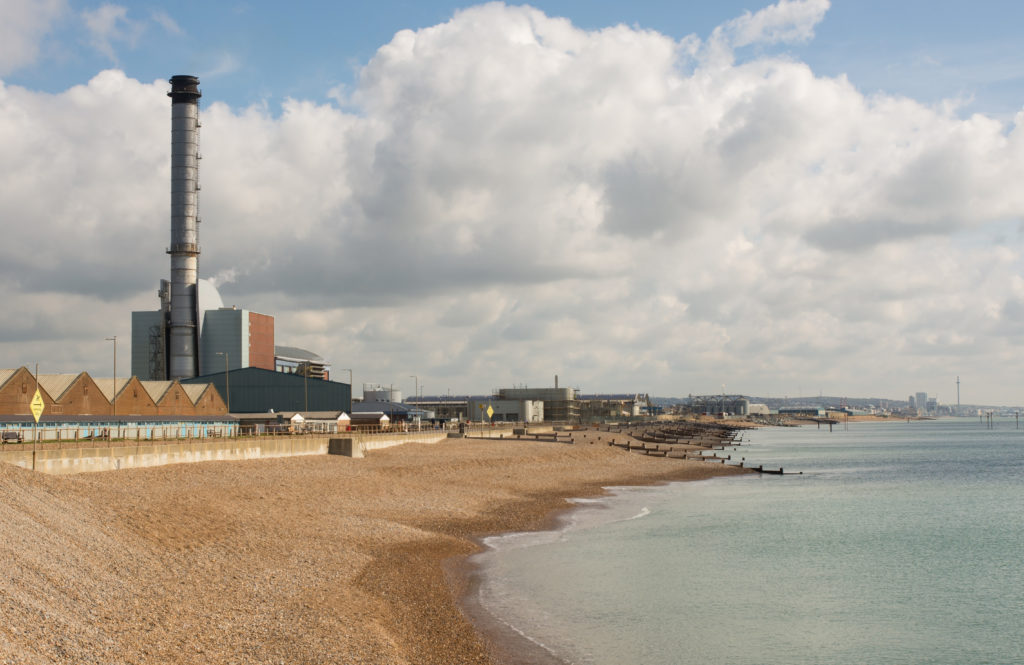Old gas works, new pollution

Brighton is famous for lots of things but surfing is not one.
The surf in Brighton is small and infrequent however that does not mean there is a void of impassioned surfers wanting to get in the water at every opportunity.
After a long lockdown, the first really swell and surfable waves came to Brighton in mid August. However, as many surfers got excited by the forecast of coming waves their hopes of surfing got wiped out when there were reports of a pollution incident. The beaches of Brighton and Hove were reported to have a strong smell of diesel which led to many groups such as Surfers Against Sewage advising that swimming, bathing and surfing were not advised at this time1. Red flags were raised, but it was still a mystery as to what was making the beaches polluted and where it had come from.

Pollution warning sign on Brighton beach taken from The Argus, 20th August 2020.
On the 19th of August 2020, Brighton and Hove City Council issued a statement saying they believed the pollution was solidified vegetable and mineral oil associated with a palm oil spill2. However, this was later disputed by the Environment Agency (EA). The EA said they were 99.9% certain the contamination was from an old gas works situated at Shoreham Port, which had operated for over 100 years and closed in the 1970s3. The EA believed it was historic hydrocarbon contamination from the former gas works which occurs regularly when the seas are rough.
This seemingly agrees with what Tony Parker, the Port’s Director for Infrastructure and Sustainability told The Argus (Brighton’s local paper) last year that contamination from the gas works usually occurs once or twice each year and has been the case for about five years, when the problem was first identified4. However, Tony Parker and Shoreham Port are denying that the most recent pollution incident was associated with the former gas work site.

Ordnance Survey mapping showing the Brighton and Hove Gas Works circa 1912.
Shoreham Port was a large industrial site which housed power stations, gas works, tanks, tunnels and depots, as well as the only access canal to reach the area. The site is still a large industrial area and being in the news for contamination is not a new phenomenon. In 1999, a warning was published cautioning that mussels found near the old gas works contained a high level of contamination which could lead to serious illness including cancer5. This was proven in a scientific paper a year later, which was published in the Marine Pollution Bulletin6.
Mysterious smells and oils associated with the gas works sites have also been reported before. In 2014, after another pollution event, complaints led to Brighton City Council writing to local residents. The letter set out the conclusions of the investigations and Shoreham Port’s intentions on future investigations. It confirmed that the pollution events did not represent a Significant Possibility of Significant Harm under Part 2A of the Environmental Protection Act 19907. The most recent pollution event comes after Tony Parker and Shoreham Port were presented with an award for solving the mystery of an obnoxious smell and seeping oil at Portslade beach8.
The Environment Agency are certain the most recent pollution event, which stopped the surfers and swimmers enjoying the sea last month, came from the former gas works site. This has since been denied by Tony Parker who said that he had not found a link between the pollution incident and the gas works, insisting that the pollution was not harmful to humans and there was no evidence linking the event to the former gas works site. This debate is likely to continue as any large scale remediation of the site s is unlikely to happen anytime soon. Tony Parker told the Argus that “in theory” it would be possible to restore the whole site, but it was unlikely more than 40 percent of the oil in the ground could be recovered. He also said the process would cost more than £100 million3.
Gas works are a common source of contamination within the UK, which can cause problems to residential and commercial property purchasers. A range of Groundsure’s reports contain a comprehensive contaminated land assessment utilising the most comprehensive data available. Unfortunately, Groundsure cannot provide any information about contamination being leaked into the sea. In the meantime, beach goers, swimmers and surfers in Brighton and Hove have been told to only swim between red and yellow flags and report any more smells and contamination to Brighton and Hove City Council.

Shoreham Port now with Brighton in the distance, Shutterstock
References:
1. Facebook.com. 2020. Surfers Against Sewage In Brighton, Hove And Shoreham. [online] Available at: <https://www.facebook.com/sasinbrighton> [Accessed 20 August 2020].
2. Twitter.com. 2020. Twitter. [online] Available at: <https://twitter.com/BrightonHoveCC/status/1296044475865849856> [Accessed 19 August 2020].
3.Churchman, L., 2020. Shoreham Port: There ‘isn’t a problem’ at the old gasworks site. The Argus, [online] Available at: <https://www.theargus.co.uk/news/18710229.shoreham-port-isnt-problem-old-gasworks-site/> [Accessed 25 September 2020].
4.Brooks, S., 2020. Brighton beach pollution is likely palm oil, officials say. The Argus, [online] Available at: <https://www.theargus.co.uk/news/18665062.brighton-beach-pollution-likely-palm-oil-officials-say/> [Accessed 25 September 2020].
5. The Argus., 2020. Poison Alert Over Mussels. [online] Available at: <https://www.theargus.co.uk/news/6798236.poison-alert-over-mussels/> [Accessed 25 September 2020].
6. Law, Robin & Kelly, Carole & Baker, K & Langford, K & Bartlett, T. (2002). Polycyclic aromatic hydrocarbons in sediments, mussels and crustacea around a former gasworks site in Shoreham-by-Sea, UK. Marine pollution bulletin. 44. 903-11. 10.1016/S0025-326X(02)00119-4. Taken from: https://www.sciencedirect.com/science/article/abs/pii/S0025326X02001194
7. Greg Minns, Environmental Health Officer, Regulatory Services, Brighton and Hove City Council, 2020. Statutory Nuisance: Environmental Protection Act 1990 Part 2A (Contaminated Land) Investigation: Environmental Protection Act 1990 Western Esplanade, Shoreham Harbour Update Re: Oil Release Onto Portslade Beach At Shoreham Harbour.. [online] Available at: <https://www.shoreham-port.co.uk/write/Shoreham_Closure_Letter_to_residents_Oct_2015.pdf> [Accessed 25 September 2020 – PDF no longer available].
8. Shoreham Herald, 2020. Shoreham Port team win award for solving beach smell mystery. [online] Available at: <https://www.shorehamherald.co.uk/news/environment/shoreham-port-team-win-award-solving-beach-smell-mystery-2123457> [Accessed 25 September 2020].
Date:
Oct 1, 2020
Author:
Patrick Hepple

